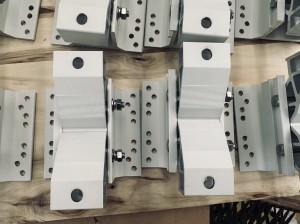Technical methods of aluminum alloy parts processing
1) Selection of processing datum
The processing datum should be as consistent as possible with the design datum, assembly datum and measurement datum, and the stability, positioning accuracy and fixture reliability of the parts should be fully considered in the processing technic.
2) Rough machining
Because the dimensional accuracy and surface roughness of some aluminum alloy parts are not easy to meet the high precision requirements, some parts with complex shapes need to be roughed before processing, and combined with the characteristics of aluminum alloy materials for cutting. The heat generated in this way will lead to cutting deformation, varying degrees of error in the size of the parts, and even lead to workpiece deformation. Therefore, for the general plane rough milling processing. At the same time, the cooling liquid is added to cool the workpiece to reduce the influence of cutting heat on machining accuracy.
3) Finish machining
In the processing cycle, high-speed cutting will produce a lot of cutting heat, although the debris can take away most of the heat, but still can produce extremely high temperature in the blade, because the aluminum alloy melting point is low, the blade is often in a semi-melting state, so that the cutting point strength is affected by high temperature, easy to produce aluminum alloy parts in the process of forming concave and convex defects. Therefore, in the finishing process, usually choose the cutting fluid with good cooling performance, good lubrication performance and low viscosity. When lubricating tools, the cutting heat is taken away in time to reduce the surface temperature of tools and parts.
4) Reasonable selection of cutting tools
Compared with ferrous metals, the cutting force generated by aluminum alloy is relatively small in the cutting process, and the cutting speed can be higher, but it is easy to form debris nodules. The thermal conductivity of aluminum alloy is very high, because the heat of the debris and parts in the cutting process is higher, the temperature of the cutting area is lower, the durability of the tool is higher, but the temperature rise of the parts themselves is faster, easy to cause deformation. Therefore, it is very effective to reduce cutting force and cutting heat by selecting appropriate tool and reasonable tool angle and improving tool surface roughness.
5) Use heat treatment and cold treatment to solve the processing deformation
The heat treatment methods to eliminate the machining stress of aluminum alloy materials include: artificial timeliness, recrystallization annealing, etc. The process route of the parts with simple structure is generally adopted: rough machining, manual timeliness, finish machining. For the process route of the parts with complex structure, it is generally used: rough machining, artificial timeliness (heat treatment), semi-finish machining, artificial timeliness (heat treatment), finish machining. While the artificial timeliness (heat treatment) process is arranged after rough machining and semi-finish machining, stable heat treatment process can be arranged after finish machining to prevent small size changes during parts placement, installation and use.
Process characteristics of aluminum alloy parts processing
1) It can reduce the influence of residual stress on machining deformation. After rough machining, it is suggested to use heat treatment to remove the stress generated by rough machining, so as to reduce the influence of stress on finish machining quality.
2) Improve machining accuracy and surface quality. After the separation of rough and finish machining, finish machining has small processing allowance, processing stress and deformation, which can greatly improve the quality of parts.
3) Improve production efficiency. Since rough machining only removes excess material, leaving enough margin for finishing, it does not consider size and tolerance, effectively giving play to the performance of different types of machine tools and improving cutting efficiency.
After aluminum alloy parts are cut, the metal structure will be changed greatly. In addition, the effect of cutting motion leads to greater residual stress. In order to reduce the deformation of parts, the residual stress of materials should be fully released.
Edited by May Jiang from MAT Aluminum
Post time: Aug-10-2023


